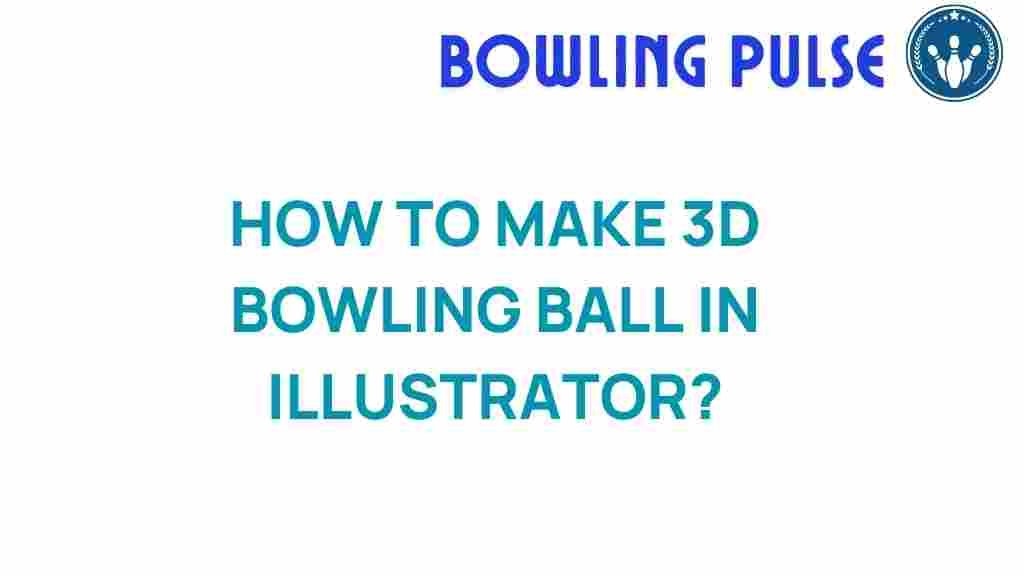Mastering 3D Design: Create Stunning Bowling Balls in Illustrator
In the world of graphic design and digital art, 3D design has become an essential skill for creating engaging and visually appealing projects. One exciting application of 3D design is creating realistic bowling balls using Illustrator. This tutorial will guide you through the step-by-step process of designing stunning bowling balls, utilizing creative techniques and visual effects in Illustrator.
Getting Started with 3D Design in Illustrator
Before diving into the actual design process, let’s ensure you have everything you need to create your bowling balls:
- Adobe Illustrator installed on your computer.
- A basic understanding of Illustrator’s interface.
- Some creativity and imagination!
Now that you’re ready, let’s explore the step-by-step process of designing bowling balls in Illustrator.
Step 1: Set Up Your Document
To begin your 3D design project, follow these steps:
- Open Adobe Illustrator and create a new document.
- Set the dimensions (e.g., 1920 x 1080 pixels) to give yourself a good workspace.
- Select RGB color mode for vibrant colors.
Step 2: Create the Base Shape
The first step in creating a bowling ball is to draw its base shape:
- Select the Ellipse Tool (L) from the toolbar.
- Hold down the Shift key while dragging to create a perfect circle.
- Fill the circle with a base color to represent the bowling ball.
Step 3: Add Texture and Patterns
To make your bowling ball more realistic, you can add texture and patterns:
- Use the Appearance Panel to add effects to your circle.
- Experiment with gradients to give the ball depth:
- Click on the gradient fill and adjust the angle for a more dynamic look.
- Use colors that represent the typical bowling ball look, such as blue, red, or black.
- Consider adding a pattern overlay by selecting a pattern from the libraries or creating your own.
Step 4: Create the 3D Effect
Now, let’s add some visual effects to give the ball a 3D look:
- Go to the Effects menu.
- Select 3D > Extrude & Bevel.
- Adjust the settings to achieve the desired 3D effect:
- Change the depth to make the ball appear rounder.
- Use the Rotation options to position the ball correctly.
Step 5: Add Highlights and Shadows
To enhance the realism of your bowling ball, you need to add highlights and shadows:
- Create a new layer for highlights.
- Use the Brush Tool (B) with a soft brush to gently paint white or light colors on the top edge of the ball.
- For shadows, create another layer and use a darker color along the bottom edge.
Step 6: Final Touches
At this stage, you should have a realistic bowling ball. Here are some final touches you can add:
- Consider adding a logo or text on the ball for personalization.
- Use the Shape Builder Tool to create holes on the ball if desired.
- Experiment with different color combinations and effects to create unique designs.
Troubleshooting Tips for 3D Design in Illustrator
While working on your bowling ball design, you might encounter some challenges. Here are some troubleshooting tips:
- Issue: The ball looks flat.
- Solution: Adjust the 3D settings and ensure you have added highlights and shadows.
- Issue: Colors don’t look vibrant.
- Solution: Check your color mode and switch to RGB if necessary.
- Issue: Effects are not appearing as expected.
- Solution: Ensure that you are working on the correct layer and that effects are applied properly.
Conclusion
Creating stunning bowling balls in Illustrator using 3D design techniques is a rewarding experience. By following this tutorial, you have learned how to set up your document, create the base shape, add textures, and apply visual effects to achieve a realistic look.
As you continue to practice your skills in graphic design and digital art, remember that creativity knows no bounds. Explore different styles, experiment with various techniques, and don’t hesitate to push your limits.
For further inspiration and design ideas, check out this resource. Happy designing!
If you want to learn more about Illustrator and its capabilities, consider visiting Adobe’s official site for additional tutorials and resources.
This article is in the category Techniques and created by BowlingPulse Team
